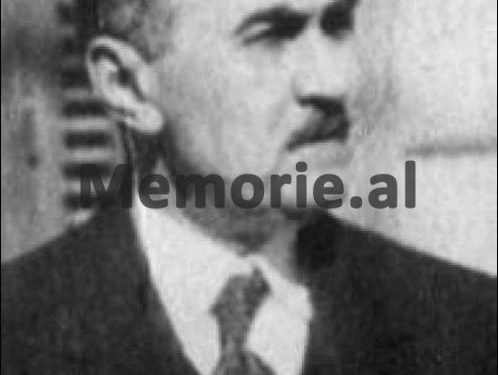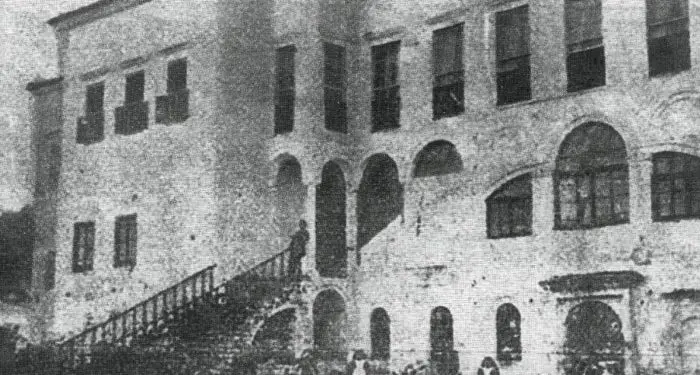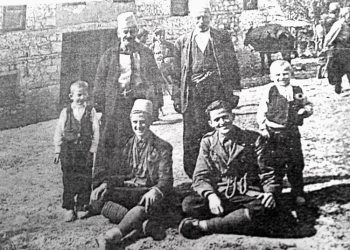Dashnor Kaloçi
Memorie.al publishes the unknown story of Ismail Qemali’s sons, from the period of the Zog Monarchy, when they were appointed to high official positions and honored with medals, decorations and special pensions. From the communist regime of Enver Hoxha, when Qamil Vlora, was imprisoned since 1947, being accused of illegal possession of weapons, while his family, until the end of the communist regime, was persecuted, denigrated and ignored, not being never invited to the anniversaries of the declaration of Independence. Rare testimony of Mrs. Esma Hurshiti Vlora, granddaughter of Javer bej Hurshiti, (former signatory of Independence in November 1912, senior official of the Zog Monarchy, prefect and mayor of Gjirokastra, MP, minister, prefect of Shkodra, Senator in the High Council of State, etc.), which tells the whole sad story of the family of her father-in-law, Qamil Vlora, (the youngest son of Ismail bey Qemali), under the communist regime of Enver Hoxha!
“At the beginning of 1945, my father-in-law, Qamil Vlora, was sought by Mehmet Shehu, who told him that he had called him to talk and get some opinions, like the son of Ismail Qemal Vlora who was. After talking for a long time, Qamil said to Mehmeti: ‘If you will know my opinion, I am telling you that many Albanians were killed with each other, so do not bleed anymore, do not kill anymore’. As Qamili himself told we when he returned home, Mehmet Shehu had called him to turn to the side of the communists, seducing him with many promises. “After the top leaders of the communist state failed to make Qamil their own, they decided to arrest and sentence him to prison.”
This is how Mrs. Esma Hurshiti Vlora (wife of Ismail Qamil Vlora, nephew of Ismail Qemali, the old man of Vlora who raised the flag and declared the independence of Albania, on November 28, 1912), remembered the meeting of Ismail Qemali’s son, among others in 1945, with Mehmet Shehu, who also showed us the unknown side of the Vlora family, during the years of the communist regime, where her father-in-law Qamili, the youngest son of Ismail Qemali, ended up in the camps and prisons of the dictatorship and the family of it was denigrated and trampled on until the late 1980s.
Although all Albanians wherever they have been, since 1912, when the old man of Vlora raised the red and black flag on the balcony of his house, have bowed respectfully, every November 28 to commemorate him, few have been who knew that, after November 28, 1944, when the communists came to power, the two sons of Ismail Qemal Vlora were still living in Tirana. Likewise, although the communist state organized large ceremonies to commemorate Flag Day, the sons and grandsons of the old man of Vlora who were still alive were never spoken of and a deep silence was maintained, erasing them from the history of Albania. , part of which, they had been fortunate to be, being their father’s closest collaborators.
The sad fate of Ismail Qemali’s ten children!
The old man of Vlora who has entered the history of Albania, with the patriotic act of raising the flag and declaring the independence of Albania, in November 1912, was married to a Greek girl named Kleoniki, with whom he had 10 children, six sons and four daughters (one daughter did not live). The three girls were older than the boys: Mahmudi, Tahiri, Ibrahimi, Ahmed, Qazimi and Qamili, who were all born in Istanbul when Ismail Qemali was a member of the Turkish parliament.
The eldest son Mahmud, (born in 1871), who at a young age worked in the Ministry of Justice in Istanbul and was convicted by the Sultan, after the escape of Ismail Qemali from Turkey, was interned for 7 years in Bitlis. After that, he joined the family in 1908, when the Young Turks Revolution won. Mahmud left Albania with his entire family when Ismail Qemali resigned from the government he headed and he died in Vlora in February 1920 (at the age of 49) and left three children with his French wife.
Tahiri the second son, (born in 1875), studied and graduated from the Navy School in Turkey and he was an advisor in this field, in the Supreme State Council. He, too, like Brother Mahmud, was exiled to Tripoli, where he served several years. After Ismail Qemali escaped to London, the Sultan sent Tahiri to persuade his father to return to Istanbul, but Ismali bey refused. Tahiri then asked his father to stay with him, but his father refused and ordered him to return to Istanbul, having given the word of honor to the Sultan, to carry out that mission.
Tahiri also left Albania with his family in 1914 and returned to his homeland in 1919. He spent the last years of his life in poverty, with a pension tied by the government of Zog, to which he was a determined opponent. Tahiri, was not married and died in Paris, on June 10, 1932 (the Albanian press wrote at the time that he had killed himself) and was buried in the French cemetery “Thiais”, where he was later buried and King Zog.
Ibrahim, the third son (otherwise known as Et’hemi), was born in 1885 and Ismail Qemali took him with him when he fled Turkey, along with two other sons, Xhevdet and Qazim. Ibrahimi accompanied his father everywhere, and in November 1912, he was assigned to head a company of soldiers, to receive Ismail bey, who was coming to declare the independence of Albania. He began his career as an officer shortly after November 1912, and he stayed close to his father in all his patriotic activities and accompanied him, along with his other brother Qazim, until the London Conference in 1913. .
Ibrahimi was also elected as the representative of the Albanian American delegation at the Paris Peace Conference in 1920. He died on May 7, 1937, in Tirana, and his funeral was held with great ceremony. His death at that time was widely echoed by all the newspapers of the time. Ibrahim was married to a girl from the well-known Tirana family, the Toptans, but they left no children.
Ahmeti, the fourth son, (born in Istanbul in 1910) and there is not much information about him about his life, as he died very young, at the age of 20 (unmarried) from tuberculosis, after being treated in a private clinic in Leysin, Switzerland.
Qazim the fifth son, (born in 1893), always stayed close to his father and was his companion. In the years 1910-1912, he took over the supply of weapons to the Albanian insurgents fighting for the declaration of independence. It is said that Qazim had an extraordinary memory and Ismail Qemali, often said that: Qazim was his memory, as he asked him about everything. In 1921, he ran for MP in Vlora, but did not win.
In the 1940s, Qazimi lived on a small pension, which was tied to him by the Albanian government of the Zog Monarchy. Qazimi was married in Tirana to Behije Ohrid and they had no children.
He was a staunch opponent of the communist regime and for this reason he left Albania and settled in Struga, where he died in December 1953, in complete poverty. It is said that Qazimi had inherited most of the documentary archive of his father, (among others the original document of the act of declaration of independence) Ismail bey Vlora and after his death, in the city of Struga a vehicle arrived from Belgrade, who seized them all and for their fate, there is no clue.
Qamil, who was the youngest of the children of Ismail bey of Vlora, (born in 1895) had the “luck” to live even after 1944 when the communists came to power in Albania, led by Enver Hoxha. During the years that the Vlora family lived in Istanbul, he was educated and stayed there, until he completed his studies in Political Science. In the years 1926-’32, Qamili served as Secretary General of the Ministry of Foreign Affairs of Albania, where he also held the position of Deputy Administrative and Consular Director.
For his diplomatic activity, in 1926 Qamil was decorated by the President of France, Gaston Doumergue, with the high decoration “Chevalier de la Legion d` Honneur” and in 1928, by the Albanian government of Prime Minister Ahmet Zogu, with the decoration “Cavalier of the Order of Skanderbeg “. Although Qamil was in charge of a high office, he was an opponent of King Zog and the Monarchical regime. Based on this fact, in August 1932, he and his family (his wife and two sons, Ismail and Xhevdet), left for Belgrade.
Qamil’s departure from Albania came as a result of the accusations made against him, as a participant in the “Vlora Movement”, where a large group of former officials and officials of the Albanian government at the time, had made a plan and wanted to overthrow Ahmet Zogu. It is not known exactly to what extent Qamil was implicated in that event, which at the time was considered an attempted “coup d’etat” that was supposed to be done to King Zog, but the accusations made against him were not baseless. .
From Yugoslavia, with the help of his friend, the Frenchman Justin Gothard, Qamil was able to leave for France, where he and his family stayed in Paris, until 1936, when the French government expelled a large number of Albanian political emigrants (anti-Zogists). ) from France. From 1936 to 1940, Qamil lived with his family in Zemun (on the outskirts of Belgrade).
After staying in emigration for about eight years, in 1940 Qamili returned with his family to Albania and settled in his house in Tirana (in a villa where today is the street “Qemal Stafa”), which he had left since when he escaped from Albania, as Zogu had not seized him. In 1940, when Qamili returned to Tirana, of Ismail Qemali’s six sons, only Qazimi was still alive, as the others had long since died.
Upon his arrival in Tirana, Qamili was summoned by the Albanian government (under fascist occupation) and began working as an advisor to the Supreme State Council. At that time, Qamil’s son (Ismaili), who had taken his grandfather’s name, was able to receive a state scholarship from the Albanian government, which was awarded him at the proposal of the Vlora district parish, as Ismail Qemal’s grandson. Vlora, to study in Vienna. The young Ismaili went to Vienna and began his studies at the Faculty of Medicine, in the Austrian capital.
But in 1942, after the war had started in Austria, his family was afraid that something would happen to him and his mother Hylvija sent him a telegram asking him to return to Albania urgently. Ismaili returned to Tirana and in order for him not to go to Vienna again, his family engaged him to Esma Hurshit, the daughter of the son of Javer Bey Hurshit, (one of the former senior officials of the Monarchy) former prefect and mayor of the Municipality of Gjirokastra, MP, Minister, Prefect of Shkodra, Senator in the High State Council, etc.
Regarding this, Esma Hurshiti Vlora, recalled: “At that time we had the house where today is the street” Qemal Stafa “and a little further on that street, lived the family of Qamil Vlora, the son of Ismail Qemali. I as a girl I was very worried about the flowers and went out to the yard every morning to water them, so it was up to me to open the gate to Qamil, who was a close friend of my father-in-law, Javeri, whom he called to go. Some mutual friends of our two families suggested to Qamil Vlora that I get engaged to his son Ismail, and Qamil himself came to our family to look for me and talked to my grandfather. , Javer Hurshitin, who was also his closest friend.
This happened at the end of October 1944, after my family received my consent for the engagement to be made, and at the end of November, I went to the prison to get the consent of my father Mehmet, to who was arrested in those days, along with his father Javer Hurshit. I remember as now that last day of November 1944, when our house, where today is the street “Qemal Stafa”, was surrounded by numerous police officers. It was morning and we children were very scared of the cop’s behavior.
My father immediately gave me his consent, saying that he was honored to give the girl to the family of Ismail Qemali’s son, with whom we had a close friendship. Although my father’s family had been one of the richest families in Gjirokastra, at that time we did not do any big ceremony for our engagement! The Vlora family was able to hold the engagement ceremony, although their house at “Moskatet” was somewhat destroyed, as partisans had fought for the liberation of Tirana.
My engagement to Ismail Vlora was not liked by the communists in Tirana, as I was the granddaughter of a former minister and prefect, whom they considered their enemy. In this connection, at that time, the communists called Ismail and put various pressures on him to leave me. This was done because the communists considered Ismail as their man, because he really, since 1942 when he returned to Albania, connected with Hysni Kapo and Manush Mufti and participated in the Anti-Fascist Movement.
The senior communist leaders did not allow Ismaili to go to Vlora, seeing the great popularity that his family had in that city, which would overshadow the communist leadership, which operated in the district of Vlora. At that time, in addition to the close friendship that Qamil had with Manush Mufti (Manushi was the grandson of Javer Hurshit’s wife), he also had close friendships with some other communists, such as: Muhamet Perja, Refit Bezhani, Mexhit Hanku, etc.
Ismaili did not even want to know about the pressures made by the communists and after that he started to cool down, to be separated from them forever. “So our engagement lasted about a year and a half and we got married there in the middle of 1946. After the marriage, Ismail and I lived at his house in Moskatet, together with our two parents and younger brother Xhevdet.” remembers Esma Hurshiti (granddaughter of Javer Bey Hurshiti) her engagement to Ismail Vlora, grandson of Ismail Qemali. Memorie.al
The next issue follows























